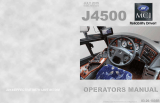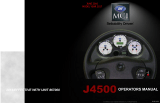
TABLE OF CONTENTS iii
TIRE MONITORING SYSTEM (TMS)........103
FIRE EXTINGUISHERS ............................104
FIRST AID KIT...........................................104
FIRE HATCHET.........................................104
WARNING REFLECTORS ........................104
JACK AND TOOLS....................................104
SPARE PARTS KIT...................................104
LIMP-HOME BELT.....................................104
SPARE WHEEL AND TIRE.....................105
CHANGING A WHEEL ..............................105
EMERGENCY AIR-FILL VALVES ...........106
EMERGENCY AND PARKING BRAKES107
JACKING POINTS...................................107
HYDRAULIC JACK....................................108
TOWING THE VEHICLE..........................108
LIFTING AND TOWING.............................109
TOWING WITHOUT LIFTING....................109
DAYTIME RUNNING LIGHTS.................110
FOG LIGHTS ...........................................110
COMPARTMENT LIGHTING...................110
MUD FLAPS AND SPLASH GUARDS....111
BACK UP CAMERA.................................111
BACK UP ALARM....................................111
ESSENTIAL FUNCTIONS TO OPERATE
THE VEHICLE (BASIC LIMP-HOME
FUNCTIONS) ..........................................111
AUDIBLE ALERTS...................................112
CARE AND MAINTENANCE .................115
CLEANING...............................................115
SEAT UPHOLSTERY................................115
PLASTIC AND VINYL................................116
WINDOWS.................................................116
WINDSHIELD............................................116
STAINLESS STEEL...................................116
FORMICA..................................................116
CARPET....................................................116
RUBBER COMPONENTS.........................116
FLOOR CLEANING...................................116
EXTERIOR SURFACES............................117
LAVATORY MAINTENANCE...................117
FILLING THE MAIN SUMP TANK .............118
DRAINING THE MAIN SUMP TANK .........118
DRAINING THE AUXILIARY
SUMP TANK..............................................118
FILLING THE FRESH WATER
RESERVOIR..............................................119
CLEANING CABINET................................119
DRAINING THE FRESH WATER
RESERVOIR..............................................119
FLUID LEVEL VERIFICATION................119
ENGINE OIL LEVEL..................................119
TRANSMISSION FLUID LEVEL................120
ALLISON TRANSMISSION FLUID LEVEL120
ZF-ASTRONIC TRANSMISSION FLUID
LEVEL........................................................121
POWER STEERING FLUID LEVEL...........121
COOLING FAN RIGHT ANGLE GEARBOX
OIL LEVEL.................................................122
DRIVE AXLE WHEEL BEARING OIL LEVEL
...................................................................122
FRONT AND TAG AXLE WHEEL HUBS...122
COOLANT FLUID LEVEL..........................122
WINDSHIELD AND HEADLIGHTS WASHER
RESERVOIRS...........................................123
OTHER VERIFICATIONS .......................123
AIR TANK PURGE.....................................123
FIRE EXTINGUISHERS ............................123
FUEL FILTER / WATER SEPARATOR .....124
BELT TENSION ADJUSTMENT................124
BACK UP CAMERA...................................125
AIR FILTER RESTRICTION INDICATOR..125
A/C AND HEATING SYSTEM
AIR FILTERS.............................................125
DRIVER'S AREA FILTER..........................125
CABIN AIR FILTER....................................126
HOSE INSPECTION..................................126
LUBRICATION...........................................126
ROUTINE INSPECTION..........................126
WITH ENGINE STOPPED.........................125
WITH ENGINE RUNNING.........................127
EXTERIOR LIGHTING VERIFICATION.....127
GENERAL RECOMMENDATIONS.........130
FIRST SERVICE ON NEW VEHICLE.....131
HOT WATER FILTER................................131
ENGINE OIL..............................................131
ALLISON TRANSMISSION FLUID FILTER
...................................................................131
WALK-AROUND INSPECTION...............133
TECHNICAL INFORMATION ................135
DIMENSIONS AND WEIGHTS ...............140
CAPACITIES ...........................................140
BAGGAGE COMPARTMENT .................140
FUEL TYPE.............................................140
WHEELS AND TIRES .............................141
RECOMMENDED TIRE INFLATION
PRESSURE AT MAXIMUM COLD LOAD..141
BELTS .....................................................141
ENGINE...................................................141
ALLISON TRANSMISSION.....................141
ZF-ASTRONIC TRANSMISSION............141
BRAKES..................................................142
BRAKE CHAMBER EFFECTIVE AREA ....142
AIR SYSTEM...........................................142
ANTILOCK BRAKING SYSTEM (ABS)...142
TROUBLESHOOTING AND TESTING......142
AUTOMATIC TRACTION CONTROL (ATC)
– ELECTRONIC STABILITY PROGRAM
(ESP) .......................................................142
STEERING ..............................................143






























